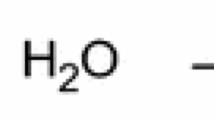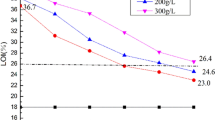Abstract
The synthesis of multi-function flame retardants is widely increasing to fulfill industrial and economic goals. In this work, a novel flame retardant, melamine salt of tannic phosphate (MTP) was prepared and characterized. MTP was mixed with polyvinyl alcohol (PVA) solution and used as a coating for cotton fabrics. In addition, tannic acid (TA) and melamine phosphate (MP) were mixed with PVA solution and applied as a coating for cotton fabrics. Vertical and horizontal flammability tests showed that the flame did not propagate in samples treated with PVA/MTP. In contrast, samples treated with PVA/TA/MP burnt completely. Limiting oxygen index (LOI) data indicated that samples treated with PVA/30%MTP reached LOI value 68.4%, while the control sample had LOI value 17.1%. Smoke density results presented that PVA/MTP succeeded in reducing the maximum specific optical density (Ds max) of cotton fabrics. FTIR gas analyzer results manifested that the addition of PVA/MTP to cotton fabrics decreased the emission of CO, CO2, C3H8, C2H6, C6H14, and formaldehyde in the gas phase. Fractional effective dose (FED) and lethal toxic potency (LC50) showed that samples coated with PVA/MTP are less toxic than blank. In addition, these fabrics exhibited a remarkable antibacterial property against gram-positive and gram-negative bacteria.










Similar content being viewed by others
References
Abdelkhalik A, Makhlouf G, Hassan MA (2019) Manufacturing, thermal stability, and flammability properties of polypropylene containing new single molecule intumescent flame retardant. Polym Adv Technol 30:1403–1414. https://doi.org/10.1002/pat.4573
Abdelkhalik A, Makhlouf G, Abdel-Hakim A (2020) Fire behavior of natural rubber filled with intumescent flame retardant containing graphite. J Vinyl Addit Technol 26(2):155–164
ASTM D6413 (2015) Standard test method for flame resistance of textiles (vertical test)
Carosio F, Negrell-Guirao C, Blasio AD, Alongi J, David G, Camino G (2015) Tunable thermal and flame response of phosphonated oligoallylamines layer by layer assemblies on cotton. Carbohydr Polym 115:752–759. https://doi.org/10.1016/j.carbpol.2014.06.066
Chan SY, Si L, Lee KI, Ng PF, Chen L, Yu B, Hu Y, Yuen RKK, Xin JH, Fei B (2018) A novel boron–nitrogen intumescent flame retardant coating on cotton with improved washing durability. Cellulose 25:843–857. https://doi.org/10.1007/s10570-017-1577-2
Chen Y, Wang Q (2007) Reaction of melamine phosphate with pentaerythritol and its products for flame retardation of polypropylene. Polym Adv Technol 18(8):587–600
Chen Y, Wang D, Liu S, Lu Y, Zhang G, Zhang F (2020) A novel P-N-based flame retardant with multi-reactive groups for treatment of cotton fabrics. Cellulose 27:9075–9089. https://doi.org/10.1007/s10570-020-03387-0
Chen Y, Wan C, Liu S, Wang P, Zhang G (2021) A novel flame retardant based on polyhydric alcohols and P-N synergy for treatment of cotton fabrics. Cellulose. https://doi.org/10.1007/s10570-020-03615-7
Chow CL, Han SS, Han GY, Hou GL, Chow WK (2020) Assessing smoke toxicity of burning combustibles by four expressions for fractional effective dose. Fire Mater 44:804–813. https://doi.org/10.1002/fam.2875
Chung C, Lee M, Choe EK (2004) Characterization of cotton fabric scouring by FT-IR ATR spectroscopy. Carbohyd Polym 58:417–420
Das AK, Islam MN, Faruk MO, Ashaduzzaman M, Dungani R, Rosamah E, Hartati S, Rumidatul A (2020) Hardwood tannin: sources, utilizations, and prospects. In: Aires A (ed) tannins structural properties, biological properties and current knowledge. IntechOpen Limited, London, pp 1–18
Dayanand C, Bhikshamaiah G, Tyagaraju VJ, Salagram M, Murthy ASRK (1996) Structural investigations of phosphate glasses: a detailed infrared study of the x(PbO)-(1–x)P2O5 vitreous system. J Mater Sci 31:1945–1967
Dong S, Wu F, Chen L, Wang Y, Chen S (2016) Preparation and characterization of Poly(vinyl alcohol)/graphene nanocomposite with enhanced thermal stability using PEtVIm-Br as stabilizer and compatibilizer. Polym Degrad Stab 131:42–52
BS EN 13501–1:2018. Fire classification of construction products and building elements. Classification using data from reaction to fire tests.
Fang F, Zhang X, Meng Y, Gu Z, Bao C, Ding X, Li S, Chen X, Tian X (2015) Intumescent flame-retardant coatings on cotton fabric of chitosan and ammonium polyphosphate via layer-by-layer assembly. Surf Coat Technol 262:9–14. https://doi.org/10.1016/j.surfcoat.2014.11.011
Gaikwad KK, Lee JY, Lee YS (2015) Development of polyvinyl alcohol and apple pomace bio-composite film with antioxidant properties for active food packaging application. J Food Sci Technol 53(3):1608–1619
Galletti GC, Reeves JB (1992) Pyrolysis/gas chromatography/ion-trap detection of polyphenols (vegetable tannins): preliminary results. Org Mass Spectrom 27:226–230
Hassan M, Nour M, Abdelmonem Y, Makhlouf G, Abdelkhalik A (2016) Synergistic effect of chitosan-based flame retardant and modified clay on the flammability properties of LLDPE. Polym Degrad Stab 133:8–15. https://doi.org/10.1016/j.polymdegradstab.2016.07.011
Hu S, Tan ZW, Chen F, Li JG, Shen Q, Huang ZX, Zhang LM (2020) Flame-retardant properties and synergistic effect of ammonium polyphosphate/aluminum hydroxide/mica/silicone rubber composites. Fire Mater 44:673–682. https://doi.org/10.1002/fam.2831
ISO 11925–2:2020. Reaction to fire tests—Ignitability of products subjected to direct impingement of flame—Part 2: Single-flame source test.
ISO 13344: 1996. Determination of the lethal toxic potency of fire effluents.
ISO 13934–1:2013. Textiles—Tensile properties of fabrics—Part 1: Determination of maximum force and elongation at maximum force using the strip method.
ISO 3795: 1989. Road vehicles, and tractors and machinery for agriculture and forestry—Determination of burning behaviour of interior materials.
ISO 4589–2:2017. Plastics—Determination of burning behaviour by oxygen index—Part 2: Ambient-temperature test.
ISO 5659–2:2017. Plastics—Smoke generation—Part 2: Determination of optical density by a single-chamber test.
ISO 13344: 2015. Estimation of the lethal toxic potency of fire effluents.
Jian R, Ai Y, Xia L, Zhao L, Zhao H (2019) Single component phosphamide-based intumescent flame retardant with potential reactivity towards low flammability and smoke epoxy resins. J Hazard Mater 371:529–539
Laoutid F, Bonnaud L, Alexandre M, Lopez-Cuesta JM, Dubois P (2009) New prospects in flame retardant polymer materials: from fundamentals to nanocomposites. Mater Sci Eng R Rep 63:100–125. https://doi.org/10.1016/j.mser.2008.09.002
Levchik SV, Levchik GF, Balabanovich AI, Camino G, Costa L (1996) Mechanistic study of combustion performance and thermal decomposition behaviour of nylon 6 with added halogen-free fire retardants. Polym Degrad Stab 54:217–222. https://doi.org/10.1016/s0141-3910(96)00046-8
Li P, Wang B, Liu Y-Y, Xu Y-J, Jiang Z-M, Dong C-H, Zhang L, Liu Y, Zhu P (2020a) Fully bio-based coating from chitosan and phytate for fire-safety and antibacterial cotton fabrics. Carbohydr Polym 237:116173. https://doi.org/10.1016/j.carbpol.2021.118263
Li P, Liu C, Xu Y-J, Jiang Z-M, Liu Y, Zhu P (2020b) Novel and eco-friendly flame-retardant cotton fabrics with lignosulfonate and chitosan through LbL: Flame retardancy, smoke suppression and flame-retardant mechanism. Polym Degrad Stab 181:109302. https://doi.org/10.1016/j.polymdegradstab.2020.109302
Liu L, Huang Z, Pan Y, Wang X, Song L, Hu Y (2018a) Finishing of cotton fabrics by multi-layered coatings to improve their flame retardancy and water repellency. Cellulose 25:4791–4803. https://doi.org/10.1007/s10570-018-1866-4
Liu Y, Wang Q, Jiang Z-M, Zhang C-J, Li Z-F, Chen H-Q, Zhu P (2018b) Effect of chitosan on the fire retardancy and thermal degradation properties of coated cotton fabrics with sodium phytate and APTES by LBL assembly. J Anal Appl Pyrolysis 135:289–298. https://doi.org/10.1016/j.jaap.2018.08.024
Makhlouf G, Hassan M, Nour M, Abdelmonem Y, Abdelkhalik A (2017a) Evaluation of fire performance of linear low-density polyethylene containing novel intumescent flame retardant. J Therm Anal Calorim 130(2):1031–1041. https://doi.org/10.1007/s10973-017-6418-x
Makhlouf G, Hassan M, Nour M, Abdelmonem Y, Abdelkhalik A (2017b) A novel intumescent flame retardant: synthesis and its application for linear low-density polyethylene. Arab J Sci Eng 42(10):4339–4349. https://doi.org/10.1007/s13369-017-2443-0
Makhlouf G, Abdelkhalik A, Hassan MA (2020) Combustion toxicity of polypropylene containing melamine salt of pentaerythritol phosphate with high efficiency and stable flame retardancy performance. Process Saf Environ Prot 138:300–311. https://doi.org/10.1016/j.psep.2020.04.012
Nabipour H, Wang X, Rahman M, Song L, Hu Y (2020a) An environmentally friendly approach to fabricating flame retardant, antibacterial and antifungal cotton fabrics via self-assembly of guanazole-metal complex. J Clean Prod 273:122832. https://doi.org/10.1016/j.jclepro.2020.122832
Nabipour H, Wang X, Song L, Hu Y (2020b) Hydrophobic and flame-retardant finishing of cotton fabrics for water–oil separation. Cellulose 27:4145–4159. https://doi.org/10.1007/s10570-020-03057-1
Nam S, Condon BD, Xia Z, Nagarajan R, Hinchliffe DJ, Madison CA (2017) Intumescent flame-retardant cotton produced by tannic acid and sodium hydroxide. J Anal Appl Pyrolysis 126:239–246. https://doi.org/10.1016/j.jaap.2017.06.003
Pan H, Wang W, Pan Y, Zeng W, Zhan J, Song L, Hu Y, Liew KM (2015) Construction of layer-by-layer assembled chitosan/titanate nanotubes based nanocoating on cotton fabrics: flame retardant performance and combustion behaviour. Cellulose 22:911–923. https://doi.org/10.1007/s10570-014-0536-4
Pantoja-Castro MA, González-Rodríguez H (2011) Study by infrared spectroscopy and thermogravimetric analysis of tannins and tannic acid. Rev Latinoamer Quím 39(3):107–112
Ramakrishnan K, Krishnan MRV (1994) Tannin—classification, analysis and applications. Anc Sci Life XII I(3–4):232–238
Singh AP, Kumar S (2020) Applications of tannins in industry. In: Aires A (ed) Tannins structural properties, biological properties and current knowledge. IntechOpen Limited, London, pp 1–19
Stec AA (2017) Fire toxicity—the elephant in the room? Fire Saf J 91:79–90. https://doi.org/10.1016/j.firesaf.2017.05.003
Stull JO (2008) U.S. Fire Administration Firefighter Autopsy Protocol, Federal Emergency Management Agency.
Tributsch H, Fiechter S (2008) The material strategy of fire-resistant tree barks. In: De Wilde WP, Brebbia CA (eds) High performance structures and materials IV. WIT Press Southampton, Boston, pp 43–52
Van der Veen I, de Boer J (2012) Phosphorus flame retardants: Properties, production, environmental occurrence, toxicity and analysis. Chemosphere 88:1119–1153. https://doi.org/10.1016/j.chemosphere.2012.03.067
Viswanath V, Leo VV, Prabha SS, Prabhakumari C, Pott, VP, Jisha MS (2015) Thermal properties of tannin extracted from Anacardium occidentale L. using TGA and FT-IR spectroscopy. Nat Prod Res 30(2):223–227. https://doi.org/10.1080/14786419.2015.1040992
Wahyono T, Astuti DA, Wiryawan IKG, Sugoro I, Jayanegara A (2019) Fourier transform mid-infrared (FTIR) spectroscopy to identify tannin compounds in the panicle of sorghum mutant lines. IOP Conf. Ser Mater Sci Eng 546042045. https://doi.org/10.1088/1757-899X/546/4/042045
Wan C, Liu M, Tian P, Zhang G, Zhang F (2020) Renewable vitamin B5 reactive N-P flame retardant endows cotton with excellent fire resistance and durability. Cellulose 27:1745–1761. https://doi.org/10.1007/s10570-019-02886-z
Wang D, Ma J, Liu J, Tian A, Fu S (2021) Intumescent flame-retardant and ultraviolet-blocking coating screen-printed on cotton fabric. Cellulose. https://doi.org/10.1007/s10570-020-03669-7
Xia Z, Singh A, Kiratitanavit W, Mosurkal R, Kumar J, Nagarajan R (2015) Unraveling the mechanism of thermal and thermo-oxidative degradation of tannic acid. Thermochim Acta 605:77–85
Xu F, Zhong L, Xu Y, Zhang C, Zhang FX, Zhang GX (2019) Highly efficient flame-retardant and soft cotton fabric prepared by a novel reactive flame retardant. Cellulose 26:4225–4240. https://doi.org/10.1007/s10570-019-02374-4
Yang B, Chen Y, Zhang M, Yuan G (2019) Synergistic and compatibilizing effect of octavinyl polyhedral oligomeric silsesquioxane nanoparticles in polypropylene/intumescent flame retardant composite system. Compos A Appl Sci Manuf 123:46–58. https://doi.org/10.1016/j.compositesa,2019.04.032
Zaikov GE, Lomakin SM (1998) Flame retardants: poly(vinyl alcohol) and silicon compounds. In: Pritchard G (eds) Plastic additives. Polymer Science and Technology Series. Springer, Dordrecht, pp 55–56.
Zhu WJ, Yang MY, Huang H, Dai Z, Cheng BW, Hao SS (2020a) A phytic acid-based chelating coordination embedding structure of phosphorus-boron-nitride synergistic flame retardant to enhance durability and flame retardancy of cotton. Cellulose 27:4817–4829. https://doi.org/10.1007/s10570-020-03063-3
Zhu XK, Pang HC, Zheng N, Tian P, Ning GL (2020b) High effects of smoke suppression and char formation of Ni-Mo/Mg(OH)2 for polypropylene. Polym Adv Technol 31:1688–1698. https://doi.org/10.1002/pat.4896
Author information
Authors and Affiliations
Corresponding author
Additional information
Publisher's Note
Springer Nature remains neutral with regard to jurisdictional claims in published maps and institutional affiliations.
Supplementary Information
Below is the link to the electronic supplementary material.
Rights and permissions
About this article
Cite this article
Makhlouf, G., Abdelkhalik, A. & Ameen, H. Synthesis of a novel highly efficient flame-retardant coating for cotton fabrics with low combustion toxicity and antibacterial properties. Cellulose 28, 8785–8806 (2021). https://doi.org/10.1007/s10570-021-04076-2
Received:
Accepted:
Published:
Issue Date:
DOI: https://doi.org/10.1007/s10570-021-04076-2




